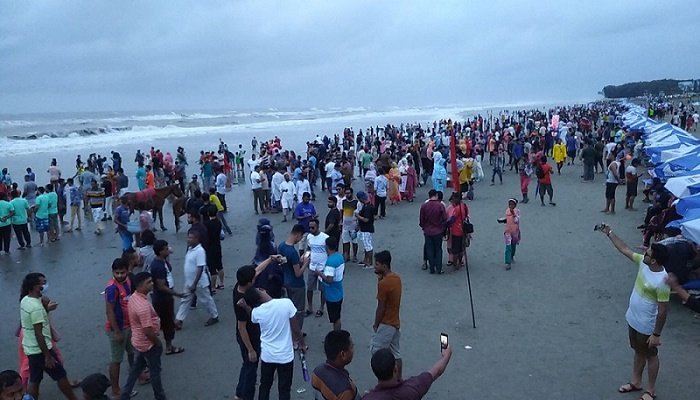Mokammel Shuvo, Cox’s Bazar: On July 18, Mohammad Tuhin, 15, a resident of Cox’s Bazar, went to Sugandha beach for swimming with three of his friends.
While the four teenagers were returning to the shore, they drifted away. Life guards managed to rescue three of them, but Tuhin remained missing.
According to life guards, a hidden canal created near the beach caused them to drift away when they were crossing the waters unaware about the canal.
There are at least six such hidden canals between Kolatoli beach to Diabetes point beach, each stretching for over one kilometre, and those are created naturally during monsoon, said Imteaz Ahmed, field team manager of Centre for Injury Prevention and Research, Bangladesh (CIPRB).
Cox’s Bazar is one of the prime tourist getaways in the country, and is visited by millions of tourists from home and abroad every year.
However, their longing for leisure at the beaches in Cox’s Bazar can be fatal.
These hidden canals pose a grave threat to tourists during the rainy season, and have already claimed the lives of three other tourists this year, Imteaz added.
CIPRB runs a project “SeaSafe”, under the International Drowning Prevention and Research Division, that is working to ensure the safety of tourists swimming in the sea, at three prominent beaches in Cox’s Bazar.
Imteaz described to this correspondent how the hidden canals become life threatening to tourists.
“During low tide, the canals are only deep up to the chest, but during high tide, these become much deeper with the current and waves also being stronger at that time.”
“At the spots where there are hidden canals, if tourists go swimming in the sea beyond knee deep water in low tide and do not return before high tide, once the water level rises and they try to return, while crossing the canals they would face powerful waves and strong current in the water that would drift them away. It would be very difficult for them to come ashore unless they are good swimmers, and this may result in fatal incidents,” Imteaz said.
This usually happens when the high tide starts during the evening, he added.
“When we see this type of situation, we try to rescue all the tourists ashore. However, we have a shortage of manpower. To avoid danger, tourists must follow the signal flags we put on the beach. If there is a red flag, they should not go swimming in the sea beyond knee deep water.”
“Awareness among the tourists is a key factor to ensuring their own safety. These hidden canals will remain till winter,” said Imteaz.
This type of canal is created due to the wind patterns and sedimentation in Cox’s Bazar, said Md Hashibul Islam, principal scientific officer and Head, Chemical Oceanography Division, Bangladesh Oceanographic Research Institute.
He said tourists have to remain cautious when they go to the sea for swimming.
Most tourists to Cox’s Bazar, like Farid Mia of Dhaka’s Jatrabari area, said they have no knowledge about the hidden canals.
Mohammad Sadek, a local youth, who along with four friends went to swim in the sea, said they know about the hidden canals.
However, claiming themselves to be good swimmers, Sadek said they are not afraid to swim during the high tide.
The existence of the canals is of much concern as thousands of tourists were seen visiting Cox’s Bazar when this correspondent went there recently, although the monsoon is not even the peak tourism season.
Many of them were seen taking baths deep into the sea, defying warnings of lifeguards.

